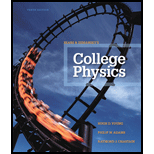
Concept explainers
(a) The recommended daily allowance (RDA) of the trace metal magnesium is 410 mg/day for males. Express this quantity in μg/day. (b) For adults, the RDA of the amino acid lysine is 12 mg per kg of body weight. How many grams per day should a 75 kg adult receive? (c) A typical multivitamin tablet can contain 2.0 mg of vitamin B2(rlboflavln), and the RDA is 0.0030 g/day. How many such tablets should a person take each day to get the proper amount of this vitamin assuming that he gets none from any other sources? (d) The RDA for the trace element selenium is 0.000070 g/day. Express this dose in mg/day.
Learn your wayIncludes step-by-step video

Chapter 1 Solutions
College Physics (10th Edition)
Additional Science Textbook Solutions
Campbell Essential Biology (7th Edition)
Campbell Biology (11th Edition)
Cosmic Perspective Fundamentals
Genetic Analysis: An Integrated Approach (3rd Edition)
Applications and Investigations in Earth Science (9th Edition)
Campbell Biology: Concepts & Connections (9th Edition)
- Frictionless surfarrow_forward71. A 2.1-kg mass is connected to a spring with spring constant 72 k = 150 N/m and unstretched length 18 cm. The two are mounted on a frictionless air table, with the free end of the spring attached to a frictionless pivot. The mass is set into circular mo- tion at 1.4 m/s. Find the radius of its path. cor moving at 77 km/h negotiat CH —what's the minimum icient of frictioarrow_forward12. Two forces act on a 3.1-kg mass that undergoes acceleration = 0.91 0.27 m/s². If one force is -1.2î – 2.5ĵ N, what's the other?arrow_forward
- 36. Example 5.7: You whirl a bucket of water around in a vertical circle of radius 1.22 m. What minimum speed at the top of the circle will keep the water in the bucket?arrow_forwardPassage Problems Laptop computers are equipped with accelerometers that sense when the device is dropped and then put the hard drive into a protective mode. Your computer geek friend has written a program that reads the accel- erometer and calculates the laptop's apparent weight. You're amusing yourself with this program on a long plane flight. Your laptop weighs just 5 pounds, and for a long time that's what the program reports. But then the "Fasten Seatbelt" light comes on as the plane encounters turbu- lence. Figure 4.27 shows the readings for the laptop's apparent weight over a 12-second interval that includes the start of the turbulence. 76. At the first sign of turbulence, the plane's acceleration a. is upward. b. is downward. c. is impossible to tell from the graph. 77. The plane's vertical ac- celeration has its greatest magnitude a. during interval B. b. during interval C. c. during interval D. 78. During interval C, you can conclude for certain that the plane is Apparent…arrow_forwardIf the metal sphere on the Van de Graff has a charge of 0.14 Coulombs and the person has a mass of 62 kg, how much excess charge would the person need in order to levitate at a distance 25 cm from the center of the charged metal sphere? Assume you can treat both the person and the metal sphere as point charges a distance 25 cm from each otherarrow_forward
- If the metal sphere on the Van de Graff has a charge of 0.14 Coulombs and the person has a mass of 62 kg, how much excess charge would the person need in order to levitate at a distance 25 cm from the center of the charged metal sphere? Assume you can treat both the person and the metal sphere as point charges a distance 25 cm from each other (so that you can use Coulomb's Law to calculate the electrical force).arrow_forwardUsing Coulomb's Law, calculate the magnitude of the electrical force between two protons located 1 meter apart from each other. (Give your answer as the number of Newtons but as usual you only need to include the number, not the unit label.)arrow_forwardPart A You want to get an idea of the magnitude of magnetic fields produced by overhead power lines. You estimate that a transmission wire is about 12 m above the ground. The local power company tells you that the line operates at 12 kV and provide a maximum of 60 MW to the local area. Estimate the maximum magnetic field you might experience walking under such a power line, and compare to the Earth's field. [For an ac current, values are rms, and the magnetic field will be changing.] Express your answer using two significant figures. ΟΤΕ ΑΣΦ VAΣ Bmax= Submit Request Answer Part B Compare to the Earth's field of 5.0 x 10-5 T. Express your answer using two significant figures. Ο ΑΣΦ B BEarth ? ? Tarrow_forward
- Ho propel 9-kN t. Boat 27. An elevator accelerates downward at 2.4 m/s². What force does the elevator's floor exert on a 52-kg passenger?arrow_forward16. 17 A CUIN Starting from rest and undergoing constant acceleration, a 940-kg racing car covers 400 m in 4.95 s. Find the force on the car.arrow_forward----- vertical diste Section 4.6 Newton's Third Law 31. What upward gravitational force does a 5600-kg elephant exert on Earth?arrow_forward
 Physics for Scientists and Engineers: Foundations...PhysicsISBN:9781133939146Author:Katz, Debora M.Publisher:Cengage Learning
Physics for Scientists and Engineers: Foundations...PhysicsISBN:9781133939146Author:Katz, Debora M.Publisher:Cengage Learning College PhysicsPhysicsISBN:9781938168000Author:Paul Peter Urone, Roger HinrichsPublisher:OpenStax College
College PhysicsPhysicsISBN:9781938168000Author:Paul Peter Urone, Roger HinrichsPublisher:OpenStax College Principles of Physics: A Calculus-Based TextPhysicsISBN:9781133104261Author:Raymond A. Serway, John W. JewettPublisher:Cengage Learning
Principles of Physics: A Calculus-Based TextPhysicsISBN:9781133104261Author:Raymond A. Serway, John W. JewettPublisher:Cengage Learning University Physics Volume 1PhysicsISBN:9781938168277Author:William Moebs, Samuel J. Ling, Jeff SannyPublisher:OpenStax - Rice University
University Physics Volume 1PhysicsISBN:9781938168277Author:William Moebs, Samuel J. Ling, Jeff SannyPublisher:OpenStax - Rice University An Introduction to Physical SciencePhysicsISBN:9781305079137Author:James Shipman, Jerry D. Wilson, Charles A. Higgins, Omar TorresPublisher:Cengage Learning
An Introduction to Physical SciencePhysicsISBN:9781305079137Author:James Shipman, Jerry D. Wilson, Charles A. Higgins, Omar TorresPublisher:Cengage Learning Glencoe Physics: Principles and Problems, Student...PhysicsISBN:9780078807213Author:Paul W. ZitzewitzPublisher:Glencoe/McGraw-Hill
Glencoe Physics: Principles and Problems, Student...PhysicsISBN:9780078807213Author:Paul W. ZitzewitzPublisher:Glencoe/McGraw-Hill





